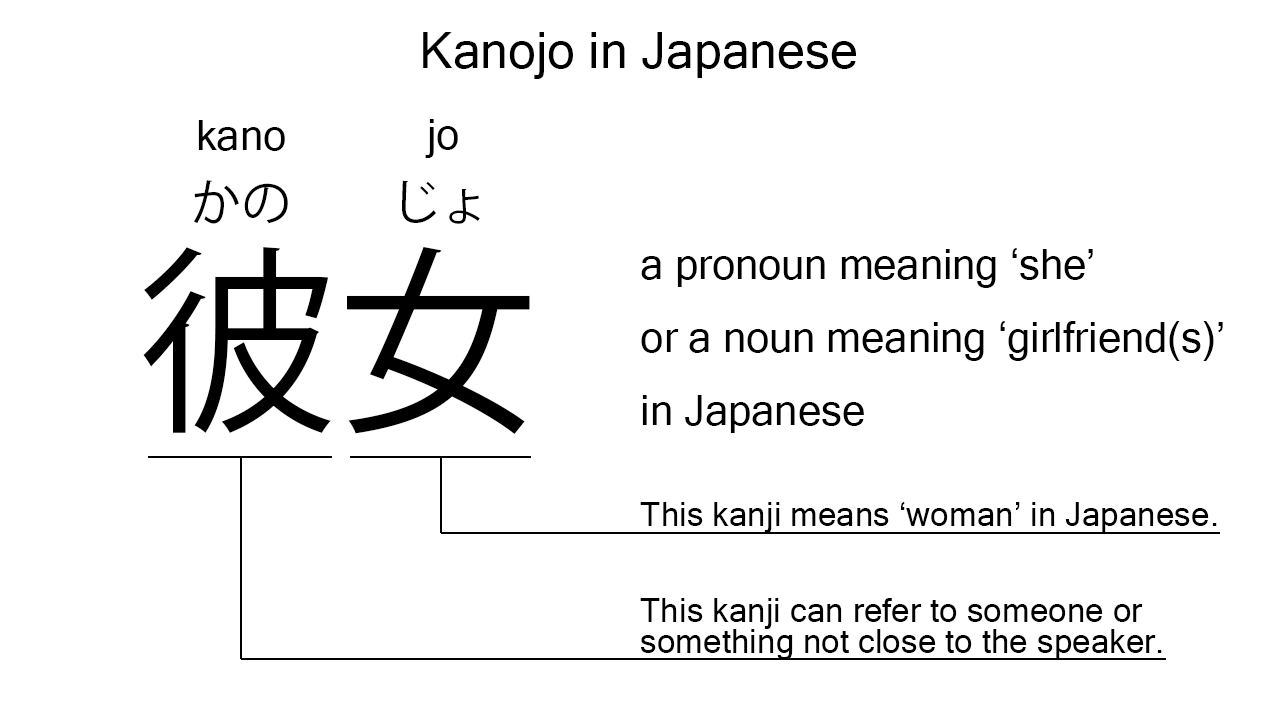What does “kanojo” mean in Japanese?
Japanese native speakers use kanojo in two different ways: to mean ‘she’ or to mean a ‘girlfriend’. Perhaps, some Japanese learners know this word as it is sometimes used in Japanese movies, songs, novels, manga, anime, and the like. In this blog post, however, I’m explaining this word in detail based on its kanji expression. And also, I’m explaining how to use it through example sentences. My explanations would help Japanese learners understand kanojo more clearly. Then, let’s get started!
Contents
Definitions and meanings of “kanojo”
Let me start with the definitions and meanings of kanojo.
- kanojo – 彼女 (かのじょ) : a pronoun used to mean ‘she’ or a noun used to mean a ‘girlfriend’ in Japanese.
Again, but Japanese native speakers use this word in two different ways: as a pronoun to refer to a girl or woman; as a noun to refer to a girl or woman who is in a romantic relationship with someone. Both usages are important, but the second one is more common especially in speaking.
The definitions and meanings are not that difficult, I think. To understand this word more clearly, however, let me explain its kanji characters in detail, one by one.
Kanojo in kanji
The kanji expression of kanojo consists of the following two kanji characters:
- 彼 : a kanji character used like a pronoun especially in the old Japanese language to refer to someone or something not close to the speaker.
- 女 : a kanji character used to mean a ‘woman’, ‘female’, or such in Japanese.
From these two kanji characters, we can understand that kanojo literally means ‘that woman’ in Japanese. This literal interpretation is not completely in line with the actual meanings, but still understandable, I think. A girl or woman not close to the speaker can often be considered as ‘she’ or ‘someone else’s girlfriend’.

When we meet new kanji expressions, we should check their kanji characters in detail to understand their meanings clearly and deeply. In many cases, kanji characters tell us a lot about the meanings of the expressions they form. Actually, here, we could get the better understanding of kanojo through the detailed kanji check above.
So far, I’ve explained the definitions and meanings of kanojo in detail together with its kanji characters. Then, let me explain how to use it through the example sentences below.
How to say “she” in Japanese
kanojo wa watashi no musume desu – 彼女は私の娘です (かのじょはわたしのむすめです)
She is my daughter.
Below are the new words used in the example sentence.
- wa – は : a binding particle working as a case marker or topic marker. In the example, this works after kanojo to make the subject in the sentence.
- watashi – 私 (わたし) : a pronoun meaning ‘I’ in Japanese.
- no – の : a case particle used after a noun or pronoun to make its possessive case. In the example, this is used after watashi to make its possessive case, watashi no, which means ‘my’ in Japanese.
- musume – 娘 (むすめ) : a noun meaning a ‘daughter’ in Japanese. This can also work as plural. Learn more about Japanese plural.
- desu – です : an auxiliary verb used after a noun or adjective to make it polite. Probably, this is well known as a part of Japanese desu form. In the example, this is used after watashi no musume to make it sound polite.
This is a typical usage of kanojo. In this example, it works as a pronoun to mean ‘she’ in Japanese. When we want to use a pronoun to refer to a girl or woman, this word is a good option.
Another example of “kanojo”
boku no kanojo wa totemo yasashii – 僕の彼女はとても優しい (ぼくのかのじょはとてもやさしい)
My girlfriend is very kind.
Below are the new words used in the example sentence.
- boku – 僕 (ぼく) : a pronoun meaning ‘I’ in Japanese. This is used mainly by boys and young males. In the example, this works together with no to mean ‘my’ in Japanese.
- totemo – とても : an adverb of degree meaning ‘very’, ‘much’, ‘so’, or such in Japanese. In the example, this works before yasashii to emphasize its meaning.
- yasashii – 優しい (やさしい) : an i-adjective meaning ‘kind’ or such in Japanese.
This is another example of kanojo. In this example, it works as a noun to mean a ‘girlfriend’ in Japanese. When it works together with a possessive case like in this example, it is most probably a noun and means a ‘girlfriend’ in Japanese. Anyway, when we want to refer to a girl or woman who is in a romantic relationship with someone in Japanese, this word is a very good option.
Summary
In this blog post, I’ve explained the definitions and meanings of kanojo in detail based on its kanji expression. And also, I’ve explained how to use it through the example sentences. Let me summarize them as follows.
- kanojo – 彼女 (かのじょ) : a pronoun used to mean ‘she’ or a noun used to mean a ‘girlfriend’ in Japanese. Both meanings are important, but the second one is more common especially in speaking. These two kanji characters literally mean ‘that woman’ in Japanese. This literal interpretation is not completely in line with the actual meanings, but still very understandable, I think. A girl or woman not close to the speaker can often be considered as ‘she’ or ‘someone else’s girlfriend’.
Hope my explanations are understandable and helpful for Japanese learners.
Leave a Reply